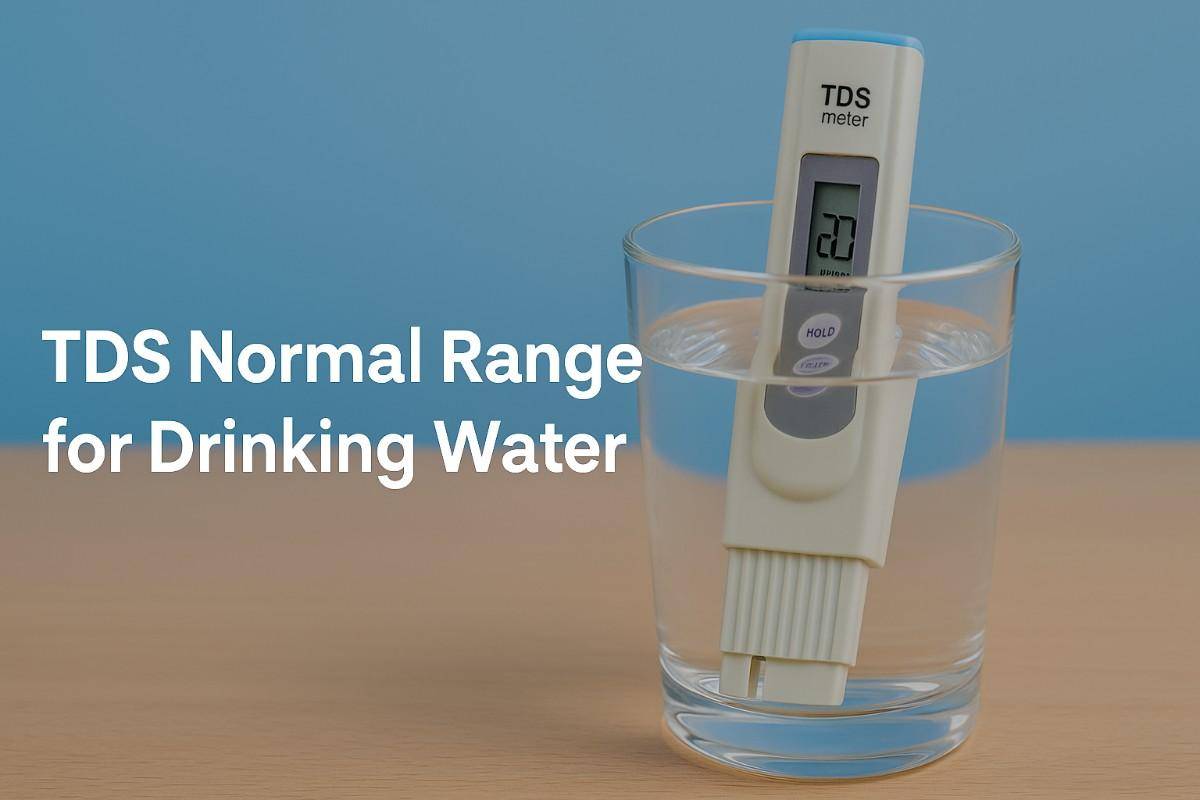share
LATEST
TDS Normal Range: Ideal TDS Level for Drinking Water Explained
Sept. 7, 2025
1245 Views
💧 Introduction: Why TDS in Drinking Water Matters
Water is essential to life, but not all water is the same. While it may appear clear and pure, water contains various minerals and impurities. One of the most crucial parameters for determining water quality is TDS – Total Dissolved Solids. But what exactly is the TDS normal range? Is high TDS harmful? What is the best TDS level for drinking water? Let’s dive deep into the facts.
🌊 What is TDS in Water?
TDS stands for Total Dissolved Solids and refers to the combined content of all inorganic and organic substances dissolved in water, including minerals, salts, and metals. TDS is measured in parts per million (ppm) or milligrams per liter (mg/L).
TDS Components May Include:
-
Calcium
-
Magnesium
-
Sodium
-
Chlorides
-
Sulfates
-
Iron
-
Potassium
-
Bicarbonates
📏 What is the TDS Normal Range?
The TDS normal range for drinking water depends on several factors, including source and treatment method. According to the BIS (Bureau of Indian Standards) and WHO, here’s the breakdown:
| TDS Level (ppm) |
Water Quality |
| 0 – 50 |
Unacceptable (too low) |
| 50 – 150 |
Excellent |
| 150 – 250 |
Good |
| 250 – 350 |
Fair |
| 350 – 500 |
Acceptable |
| 500 – 1200 |
Poor – Not ideal |
| Above 1200 |
Unfit for consumption |
✅ Recommended TDS Level:
Ideal TDS for drinking water: between 80 to 250 ppm
Upper safe limit as per BIS: 500 ppm
🥤 Best TDS Level for Drinking Water
The best TDS level for drinking water is between 100 – 300 ppm. At this range:
Water below 80 ppm may lack essential minerals like calcium and magnesium and can be considered too soft or demineralized.
🇮🇳 TDS Normal Range in India
As per BIS IS 10500:2012, the acceptable limit of TDS in drinking water in India is:
However, for RO purified water, it’s ideal to keep it between 100–250 ppm to retain essential minerals.
❓ Is 25 TDS Safe for Drinking Water?
Short answer: NO.
Water with TDS of 25 ppm is too low and may lack essential minerals such as calcium and magnesium. Regular consumption can:
💡 WHO states that extremely low TDS water may be corrosive and have adverse effects on metabolism.
💧 RO Water TDS Level: What Should It Be?
RO (Reverse Osmosis) purifiers reduce TDS, but over-purification is a risk. RO water should have TDS:
-
Minimum: 80 ppm
-
Ideal: 100–250 ppm
-
Maximum: 350 ppm
Water below 80 ppm from RO may need TDS controllers or mineral cartridges to restore essential minerals.
📊 RO Water TDS Level Chart:
| TDS Range |
Suitability for RO Output |
| < 50 ppm |
Unsafe, lacks minerals |
| 50-80 ppm |
Low, add mineral cartridge |
| 80-150 ppm |
Ideal RO output |
| 150-300 ppm |
Good mineral balance |
| 300+ ppm |
May not require RO |
🛑 Minimum TDS for Drinking Water
The minimum safe TDS for drinking water is considered to be 80–100 ppm, as per health and taste guidelines.
Too low TDS (<50 ppm) may:
Always ensure a TDS balance in RO-filtered water.
📍 Water TDS Normal Range Globally
| Region |
TDS Recommendation |
| India (BIS) |
Up to 500 ppm |
| WHO Guideline |
< 300 ppm (ideal) |
| USA (EPA) |
500 ppm (limit) |
| EU |
500 ppm |
🚗 MLD, KLD & TDS: Related Industry Terms
-
MLD (Million Liters per Day) – Common in water treatment plants
-
KLD (Kilo Liters per Day) – Smaller water supply measurements
-
TDS is critical in both MLD and KLD water quality parameters
🧠 Frequently Asked Questions (FAQs)
❓ What is the normal TDS of drinking water in ppm?
Answer: Normal TDS for drinking water should be between 80 to 300 ppm for balanced taste and mineral content.
❓ What is the best TDS level for RO water?
Answer: Best TDS level for RO-purified water is 100 – 250 ppm.
❓ Is 25 TDS safe for drinking water?
Answer: No, 25 ppm is too low and lacks essential minerals like calcium and magnesium.
❓ What is TDS full form?
Answer: TDS stands for Total Dissolved Solids.
❓ What is the acceptable TDS limit in India?
Answer: As per BIS, 500 ppm is the desirable limit; 2000 ppm is max permissible if no alternative source is available.
❓ Can high TDS be harmful?
Answer: Yes. High TDS (>500 ppm) may contain nitrates, sulfates, and heavy metals that affect health.
❓ Does RO remove all TDS?
Answer: Yes, RO removes up to 95–98% of TDS, which is why post-mineralization is necessary.
🖼️ Thumbnail Suggestion (For Blog)
-
High-quality digital image showing a TDS meter in a glass of water
-
Text overlay: “TDS Normal Range for Drinking Water”
-
Blue and white color palette for trust and cleanliness
If you'd like, I can generate the thumbnail image for you now.
✅ Final Tips for Ranking This Blog in Top 1:
-
Use all keywords in H1–H3 headings and alt text for images
-
Include TDS comparison chart, schema, and FAQs for featured snippets
-
Share internally on relevant pages: RO purifiers, water testing, health blogs
-
Add outbound links to WHO, BIS, and health journals for authority
share Share now









